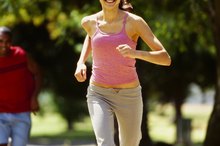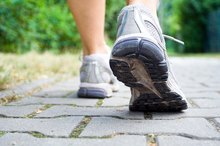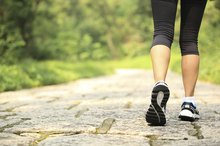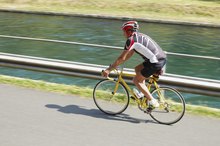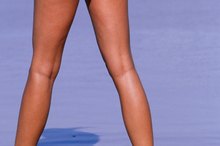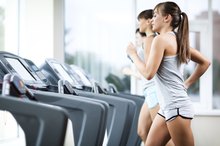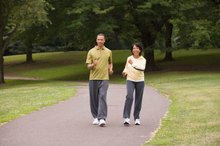What does fact checked mean?
At Healthfully, we strive to deliver objective content that is accurate and up-to-date. Our team periodically reviews articles in order to ensure content quality. The sources cited below consist of evidence from peer-reviewed journals, prominent medical organizations, academic associations, and government data.
- MayoClinic.com; Exercise for Weight Loss; Calories Burned in 1 Hour; December 2009
- Harvard School of Public Health: Strength and Flexibility Training
The information contained on this site is for informational purposes only, and should not be used as a substitute for the advice of a professional health care provider. Please check with the appropriate physician regarding health questions and concerns. Although we strive to deliver accurate and up-to-date information, no guarantee to that effect is made.
Does Walking Help You Lose the Fat Around Your Waist?
Walking burns excess body fat. However, it does not target the fat around your waist because you cannot spot-reduce. To burn fat around your waist — and everywhere else on your body — do at least one hour of brisk walking every day. Vary your walking route, pace and style to add new challenges, build muscle, increase your endurance and boost fat-burning. If you have injuries or medical issues, speak with a doctor before implementing a vigorous walking regimen.
Walking Pace
To burn fat effectively and trim your waistline, you need to walk quickly for a sustained period. Strolling or stopping and starting do not elevate your heart rate enough to burn many calories. Walking a 30-minute mile burns only 180 to 270 calories per hour, while walking an 18-minute mile burns 275 to 415 calories in one hour 1. Walk a challenging 12-minute mile and burn 585 to 875 calories in one hour. If you burn 500 calories walking every day, you lose 1 lb 1. of fat per week.
Climbing
Does Jogging Reduce Thigh Size?
Learn More
Vary your walking workout, burn more calories and strengthen your abdomen, thighs and calves by climbing hills, moderate grades or stairs. Climbing stairs burns 660 to 980 calories per hour. Hiking up hills burns 440 to 655 calories per hour. Add a weighted pack, and you burn 510 to 765 calories in one hour. In addition, the muscle tissue you add to your lower body raises your resting metabolic rate so you burn more calories even when you're not exercising.
- Vary your walking workout, burn more calories and strengthen your abdomen, thighs and calves by climbing hills, moderate grades or stairs.
- Add a weighted pack, and you burn 510 to 765 calories in one hour.
Speed Intervals
Increase the fat you burn during your walking workout by doing speed intervals. Warm up by walking slowly and then moderately. After 10 minutes, walk vigorously for five minutes. Then, break into a sprint, either running, jogging, race-walking, jumping rope or doing another intense activity. After 30 seconds to one minute, slow down to rest, but keep moving. Return to your vigorous walk. Do speed intervals every five minutes and you spike your heart rate, build endurance and burn more belly fat.
- Increase the fat you burn during your walking workout by doing speed intervals.
- Do speed intervals every five minutes and you spike your heart rate, build endurance and burn more belly fat.
Engaging Your Core
How to Get Skinny From Walking
Learn More
Using proper form during your walking workout reduces your chances of injury, and it also strengthens your abdominal muscles so you look slimmer around your waist. Inhale deeply and contract your abdominal muscles. When you exhale, keep your muscles contracted. The contraction supports your back so you stand up straighter while walking. You gradually increase your core strength, adding muscle tissue and toning abdominal muscles.
- Using proper form during your walking workout reduces your chances of injury, and it also strengthens your abdominal muscles so you look slimmer around your waist.
Related Articles
References
- MayoClinic.com; Exercise for Weight Loss; Calories Burned in 1 Hour; December 2009
- "The New York Times"; A Healthy Mix of Rest and Motion; Peter Jaret; May 2007
- Harvard School of Public Health: Strength and Flexibility Training
- Wilkin LD, Cheryl A, Haddock BL. Energy expenditure comparison between walking and running in average fitness individuals. J Strength Cond Res. 2012;26(4):1039-44. doi:10.1519/JSC.0b013e31822e592c
- Ainsworth BE, Haskell WL, Herrmann SD, et al. 2011 Compendium of Physical Activities: a second update of codes and MET values. Med Sci Sports Exerc. 2011;43(8):1575-81. doi:10.1249/MSS.0b013e31821ece12
- Loftin M, Waddell DE, Robinson JH, Owens SG. Comparison of energy expenditure to walk or run a mile in adult normal weight and overweight men and women. J Strength Cond Res. 2010;24(10):2794-8. doi:10.1519/JSC.0b013e3181cc26cd
- Ainsworth BE, Haskell WL, Herrmann SD, Bassett DR Jr, Tudor-Locke C, Greer JL, Vezina J, Whitt-Glover MC, Leon AS. 2011 Compendium of Physical Activities. Medicine & Science in Sports & Exercise. 2011;43(8):1575-1581. doi:10.1249/mss.0b013e31821ece12.
- Wilkin LD, Cheryl A, Haddock BL. Energy Expenditure Comparison Between Walking And Running In Average Fitness Individuals. Journal of Strength and Conditioning Research 26.4 (2012): 1039-1044.
Writer Bio
Nina Makofsky has been a professional writer for more than 20 years. She specializes in art, pop culture, education, travel and theater. She currently serves as a Mexican correspondent for "Aishti Magazine," covering everything from folk art to urban trends. She holds a Bachelor of Arts in English from Mills College.
